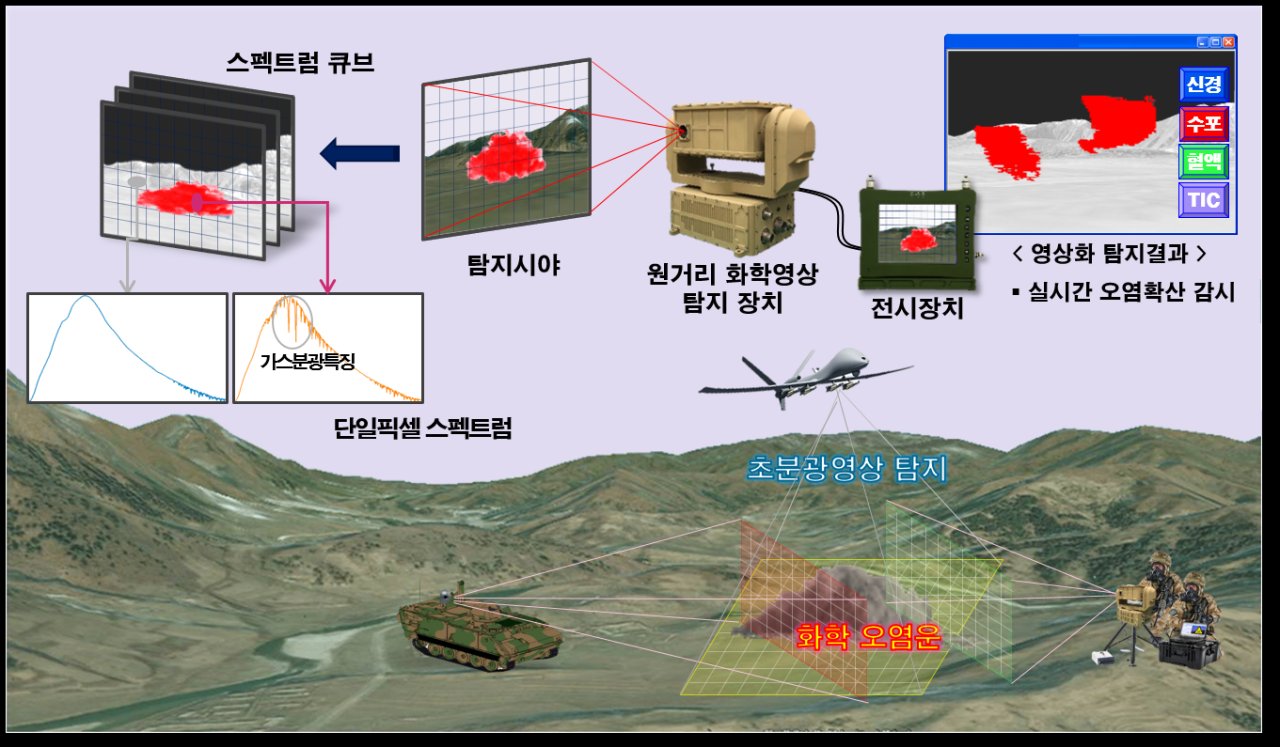 |
South Korea has developed a Hyperspectral Imaging Stand-off Chemical Agent Detection System. (Agency for Defense Development) |
South Korea has developed its first homegrown technology for early detection of chemical weapons attacks at long distances, the state-run weapons development agency announced Wednesday.
The Agency for Defense Development said it had independently secured a “Hyperspectral Imaging Stand-off Chemical Agent Detection System,” which provides early warnings by monitoring and identifying the transmission of Chemical Warfare Agents or CWAs in contaminant plumes.
The new remote sensing technology monitors the spread of contamination in real time in case of chemical attacks, by analyzing 2D images and spectral information of infrared radiation. The technology now enables South Korea to visualize the spreading path of chemical agents.
According to the ADD, Seoul is expected to “secure the ability to quickly and effectively respond to chemical weapons threats,” and minimize the damage of chemical attacks based on the new technology.
The portable and lightweight chemical warfare agent detector can be installed on a variety of platforms, including manned and unmanned reconnaissance systems.
The ADD said it would work toward applying the secured technology to the development of “weapons systems” for detecting chemical agents with a hyperspectral imaging infrared sensor.
The technology used in the detectors will be “actively” transferred to related private companies, the agency added.
The agency also said it would seek to focus on enhancing military strength and private-public joint readiness capabilities against terrorism. And as part of efforts, the agency will develop core technology for remotely detecting biological warfare agents.
The ADD explained that the chemical agent detector was the outcome of a research and development project initiated in 2012 as part of the core technology project spearheaded by South Korea’s Defense Acquisition Program Administration.
The agency said the chemical agent early detection equipment was developed for various purposes, including chemical accidents where hazardous substances leak.
But the development of such technology is noteworthy considering North Korea’s enhanced chemical and biological weapons capabilities.
The Pentagon particularly said North Korea was the “third-largest possessor of chemical agents in the world” in its report on North Korean Tactics released in July last year.
In the report, the US Army estimated that Pyongyang possesses 2,500–5,000 metric tons of chemical weapons and develops 20 different types of chemical weapons programs, including the highly toxic sarin and VX chemical agents. The US Army also braced for the possibility of Pyongyang using chemical artillery shells.
In general, South Korea’s ADD has stepped up its efforts to take countermeasures to terrorism, including attacks with chemical, biological, and radiological or CBR weapons.
Seoul has also developed technology for predicting the transmission path of CBR agents in real time and quickly taking measures in case of attacks. The agency announced the technical development in late October as the outcome of the three-year project starting in 2018.
The technology aims to help the country to have a more accurate understanding of the situation in the event of CBR attacks, by providing high-resolution images of contamination and transmission path of CBR agents across the country including populated downtown areas.
The ADD said Seoul would be able to enhance disaster response capabilities and minimize damage to the public, government agencies, and the military in the event of CBR warfare.
By Ji Da-gyum (
dagyumji@heraldcorp.com)







![[Today’s K-pop] Blackpink’s Jennie, Lisa invited to Coachella as solo acts](http://res.heraldm.com/phpwas/restmb_idxmake.php?idx=644&simg=/content/image/2024/11/21/20241121050099_0.jpg)
